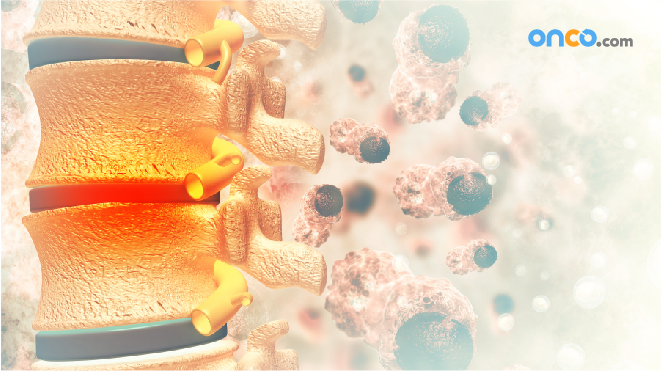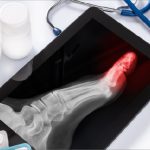What are the types of bone cancer?
Bone cancers classified into primary and secondary. Primary bone cancer is the cancer that forms in the cells of bone. Secondary bone cancer is that cancer which spreads to bone from another part of the body (example cancers from lung, prostate, breast, kidney etc.). The most common cancers of bone are secondary bone cancer.

There are five main types of primary bone cancer.
1. Chondrosarcoma
A malignant bone tumor that arises from cells of the cartilage either from the normal bone (primary chondrosarcoma) or in a pre-existing cartilaginous tumor-like enchondroma (secondary chondrosarcoma). It may arise from any bone but is common in flat bones such as ribs, scapula, and ribs.
2. Ewing Sarcoma (pronounced you-ing)
This is a highly malignant tumor that is more common in teenagers and young adults but can occur in any age.
Listed below are the features of Ewing Sarcoma
- Bones affected: It commonly occurs in long bones like the femur and tibia, and less commonly in flat bones like the pelvis and the calcaneus. Occasionally, it is known to have a multicentric origin.
- Site: It may begin anywhere but diaphysis of the long bone is most common.
3. Osteosarcoma (Osteogenic Sarcoma)
It is the second most common and a highly malignant primary bone tumor.
It is defined as a malignant tumor of the mesenchymal cells, characterized by the formation of osteoid or bone by the tumor cells.
a) Primary Osteosarcoma
Most primary osteosarcomas have the following important features:
- Age at onset: These tumors occur between the ages of 15-25 year, constituting the commonest musculoskeletal tumor at that age.
- Common sites of origin: In decreasing order of frequency these are: the lower-end of the femur; the upper end of the tibia; and the upper end of the humerus. However, any bone in the body may be affected.
b) Secondary Osteosarcoma
When osteosarcoma develops in a bone affected by a premalignant disease (like Piaget’s or Enchondromatosis) it is known as secondary osteosarcoma. It is less malignant and affects people older than 45 years of age. Treatment is similar to mainstream osteosarcoma.
c) Parosteal Osteosarcoma
This arises from the region of the periosteum. It occurs mostly in adults and is a slower growing tumor. Treatment is similar to osteosarcoma but the prognosis is preferable.
4. Fibrosarcoma
Fibrosarcoma is a rare type of cancer that affects cells known as fibroblasts. Fibroblasts are responsible for creating fibrous tissue throughout the body like in tendons which connect muscle to bone and other soft tissue like ligaments, fat or muscle.
Listed below are the features of Fibrosarcoma:
- Fibrosarcoma, after onset multiplies and creates extra tissue that affects the region surrounding it.
- Site: It may begin anywhere in soft tissue around the bones like tendons, ligaments and fat.
Diagnosis:
The American Cancer Society enlists a variety of tests to be carried out regularly for the diagnosis of soft tissue sarcomas. Diagnosis is confirmed by the following means:
- Biopsy
- X-ray
- Computer tomography (CAT or CT) scan
- Magnetic resonance imaging (MRI)
- Positron emission tomography (PET) scan
Read more on Screening tests for bone cancer
Treatment:
Treatment for fibrosarcoma depends on the stage of cancer. It may vary from surgery to remove cancer to radiation and chemotherapy to treat it. There may also be a requirement for surgery to remove lymph nodes or cancer which has spread to lungs.
5. Chordoma
Chordoma is a very rare variety of bone cancer which is slow growing and slow spreading. Chordomas develop from the notochord which forms early spinal tissue in a fetus. The six-month fetus develops a bone which replaces the tissue but in some cases, the notochord may remain. 2 out of 5 chordomas grow in the skull or the bones of the middle face while the rest grows in the spinal cord.
Listed below are the features of Chordoma
- Chordoma in the skull may cause the patient to have double vision, headaches, weaknesses, and paralysis in the face; while those in the spine cause pain, difficulty in passing of urine and weakness in legs; those in the upper back may cause difficulty in swallowing food.
- Site: They are found within the tissue of the spinal canal and are sometimes classified as bone tumors or central nervous system tumors.
Diagnosis:
The doctor may advise multiple blood tests to inspect overall general health. Other tissues may include:
- CT scan
- MRI scan
- Biopsy
Treatment:
Treatment depends on the location and the severity of the chordoma. It is important that it is diagnosed as soon as possible to prevent recurrence of cancer. Surgery to remove as much of the tumor as is possible and radiation therapy to remove any remaining cells is important to prevent other symptoms from relapsing.



